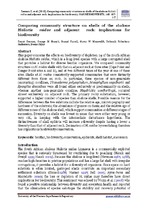| dc.contributor.author | Zeeman, Zannè | |
| dc.contributor.author | Branch, George M. | |
| dc.contributor.author | Farrell, Daniel | |
| dc.contributor.author | Maneveldt, Gavin | |
| dc.contributor.author | Robertson-Andersson, Deborah | |
| dc.contributor.author | Pillay, Deena | |
| dc.date.accessioned | 2014-01-15T06:37:34Z | |
| dc.date.available | 2014-01-15T06:37:34Z | |
| dc.date.issued | 2013 | |
| dc.identifier.citation | Zeeman, Z. et al. (2013). Comparing community structure on shells of the abalone Haliotis midae and adjacent rock: implications for biodiversity. Marine Biodiversity, 160: 107- 117 | en_US |
| dc.identifier.issn | 1867-1616 | |
| dc.identifier.uri | http://hdl.handle.net/10566/952 | |
| dc.description.abstract | This paper concerns the effects on biodiversity of depletion 24 of the South African
abalone Haliotis midae, which is a long-lived species with a large corrugated shell
that provides a habitat for diverse benthic organisms. We compared community
structure on H. midae shells with that on adjacent rock at three sites (Cape Point and
Danger Point sites A and B), and at two different times of the year at one of these
sites. Shells of H. midae consistently supported communities that were distinctly
different from those on rock. In particular, three species of non-geniculate
(encrusting) corallines, Titanoderma polycephalum, Mesophyllum engelhartii and
Spongites discoideus were all found either exclusively or predominantly on shells,
whereas another non-geniculate coralline, Heydrichia woelkerlingii, occurred
almost exclusively on adjacent rock. The primary rocky substratum, however,
supported a higher number of species than abalone shells. Possible reasons for the
differences between the two substrata include the relative age, microtopography and
hardness of the substrata; the abundance of grazers on them; and the relative age of
different zones of the abalone shell, which support communities at different stages of
succession. Diversity on shells was lowest in zones that were either very young or
very old, in keeping with the intermediate disturbance hypothesis. The
distinctiveness of shell epibiota will increase diversity despite having a lower
diversity than that of adjacent rock. Decimation of H. midae by overfishing therefore
has implications biodiversity conservation. | en_US |
| dc.language.iso | en | en_US |
| dc.publisher | Springer Verlag | en_US |
| dc.rights | This is the author's final draft following peer review. It may be displayed and circulated, subject to full acknowledgement of author and source. The published item is copyright Springer Verlag. | |
| dc.source.uri | http://dx.doi.org/10.1007/s00227-012-2067-6 | |
| dc.subject | Benthic | en_US |
| dc.subject | Biodiversity | en_US |
| dc.subject | Conservation | en_US |
| dc.subject | Epibionts | en_US |
| dc.subject | Shell habitat | en_US |
| dc.subject | Succession | en_US |
| dc.title | Comparing community structure on shells of the abalone Haliotis midae and adjacent rock: implications for biodiversity | en_US |
| dc.type | Article | en_US |
| dc.privacy.showsubmitter | false | |
| dc.status.ispeerreviewed | true | |
| dc.description.accreditation | Web of Science | en_US |

